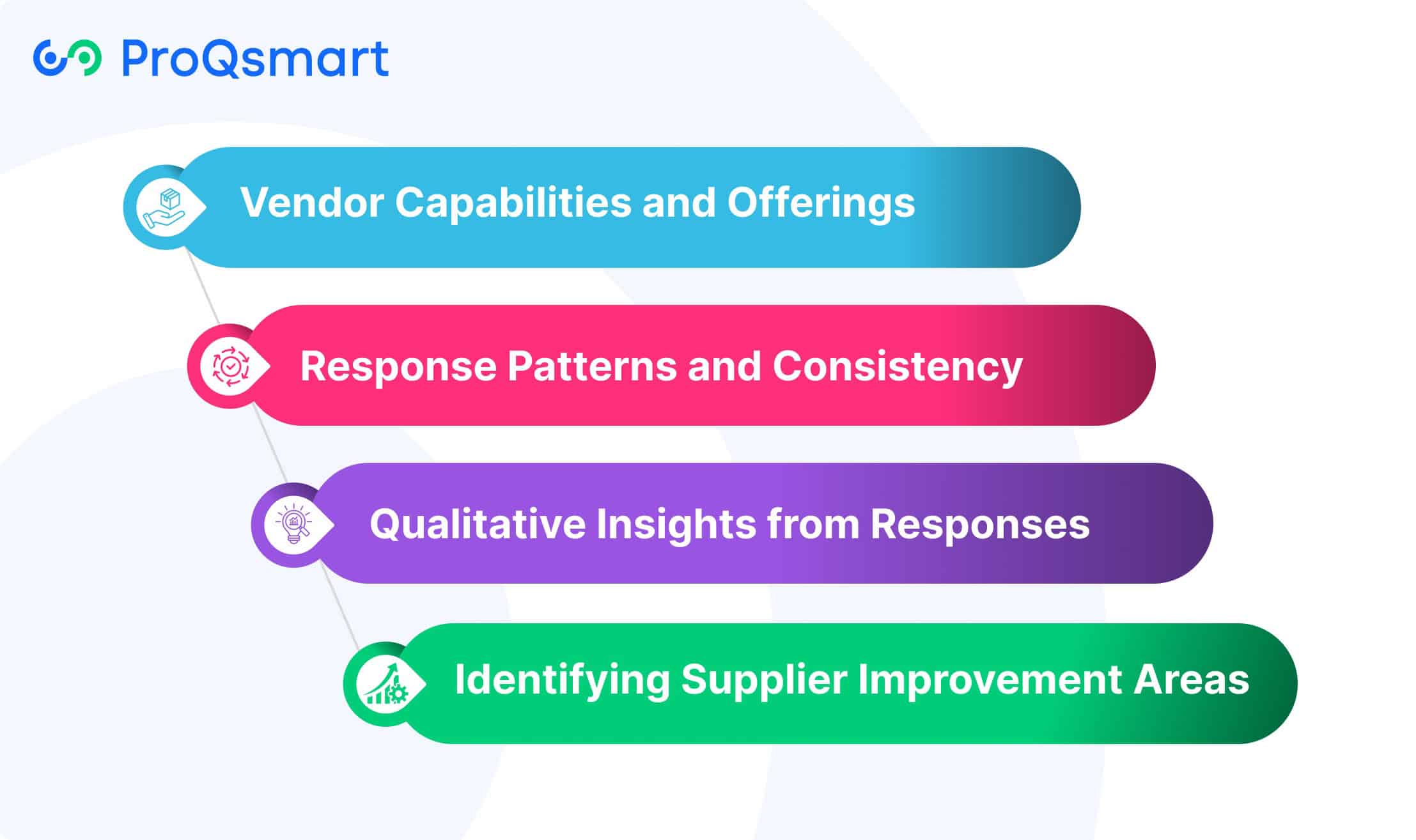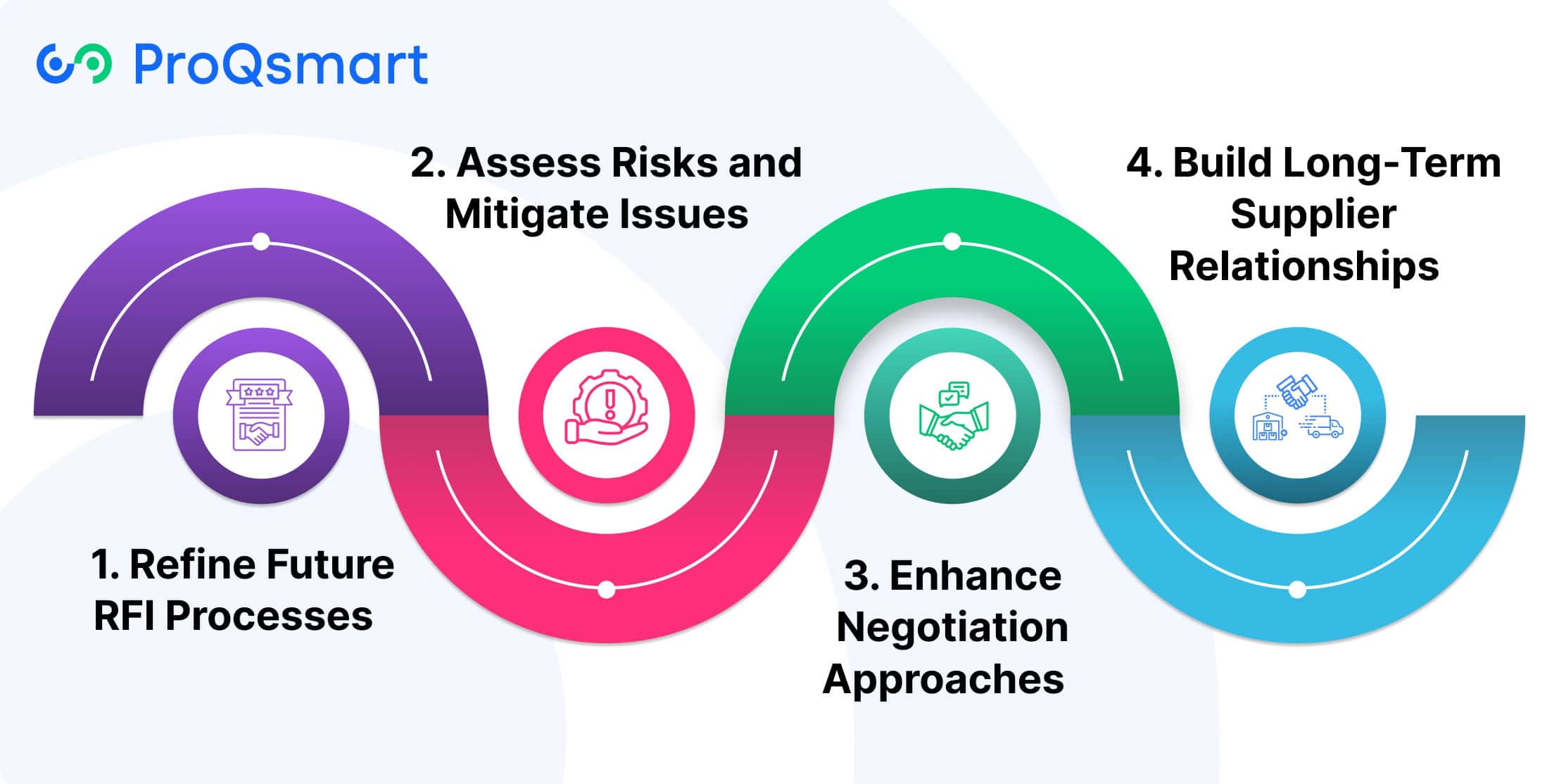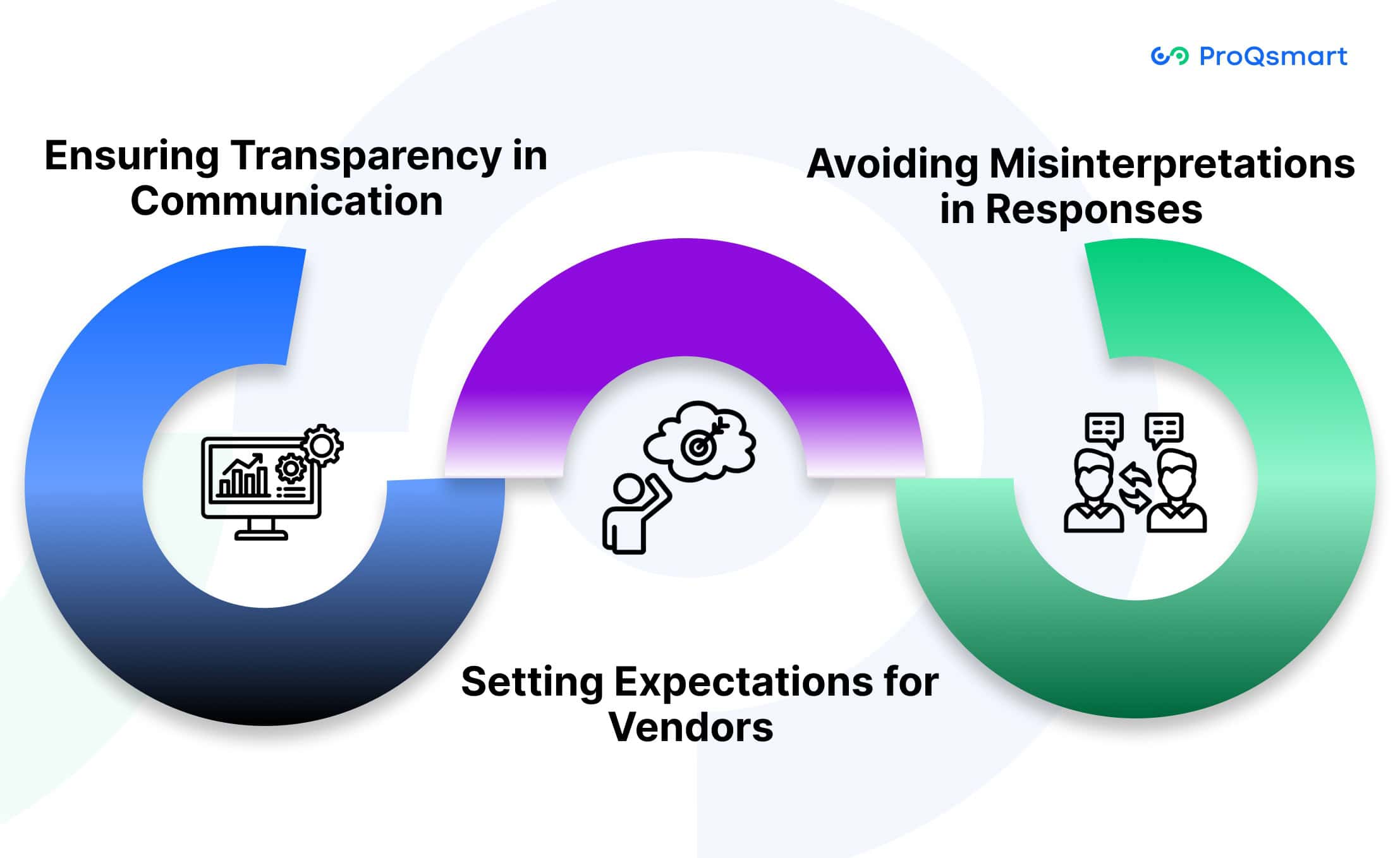An RFI, or Request for Information, is a very serious formal document. Strategically deployed, organizations can use it to elicit in-depth, qualitative insights from potential suppliers or vendors.
It is a great first step in any procurement process, allowing businesses to better gauge market capabilities, supplier offerings, and available solutions. By implementing RFIs, organizations can help simplify the vendor selection process, helping to identify qualified suppliers and mitigate risks in business decisions.
This tool becomes even more useful in larger, more complicated projects, where in-depth understanding is critical to successfully delivering on the business intent. RFIs contribute to transparency and efficiency by standardizing the type of information gathered from several different vendors.
So it’s essential that procurement professionals learn how to master the RFI process. It’s critical for developing productive supplier partnerships and delivering on strategic sourcing objectives efficiently.
Strategic Importance of an RFI
A Request for Information (RFI) is a huge foundational piece in today’s procurement environment. This tool isn’t just about evaluating vendors. Strategically, it positions organizations to better align sourcing efforts with broader policy and social equity goals, all while uncovering opportunities for enhanced cost savings, innovation, and compliance.
By incorporating RFIs into their procurement strategies, companies can maneuver through today’s complex markets with greater precision, while building stronger relationships with suppliers.
Role Beyond Vendor Selection
RFIs are helpful tools in our arsenal to solicit important market intelligence. More than just a measure of vendor capabilities, they offer a clearer picture of industry trends, developments, and innovations. Organizations seeking to implement sustainable procurement practices can use RFIs to identify suppliers that offer environmentally conscious solutions.
This strategy allows them to better pursue environmental objectives with the power they wield. RFIs can give you a high-level view of emerging technologies, such as artificial intelligence and cloud computing. This allows companies to avoid being left behind in dynamic, innovation-driven markets.
This understanding aids in not just short term vendor selection but informs longer term procurement strategy.
Contribution to Long-Term Planning
An RFI can be a useful, proactive tool for forecasting future procurement needs. By evaluating responses, organizations can find patterns in the capabilities of the entire supply chain and position themselves for smart supplier development. Companies that implement a structured RFI process achieve 20% higher quality of supplier relationship.
This impressive statistic illustrates the remarkable value of creating lasting relationships. In addition, RFIs bring strategic focus to procurement activities, ensuring that resources are directed in support of organizational objectives for continued growth.
Insights into Market Trends
RFI data provides an unparalleled look into the future of technology and market evolution, making it incredibly valuable and actionable. By analyzing vendor responses, businesses can spot larger trends in consumer expectations or the competitive landscape.
For instance, the pricing and delivery terms submitted while in the RFI phase can reveal the most cost-effective and efficient opportunities while maintaining a level of quality. This allows agencies to prioritize better and deliver more impactful projects, creating happier customers and more operationally resilient organizations.
Key Elements in RFI Responses

When you’re reviewing responses to an RFI, consider these important factors. These elements will provide you an unvarnished look at each vendor’s fit. An RFI done well is about more than just collecting responses. They can provide critical information about vendor capabilities, reliability, and fit with your organization’s goals.
Vendor Capabilities and Offerings
Getting to know what a vendor can really bring to the table starts with a deep dive into their specialties and offerings. RFI responses should include non-proprietary information to substantiate capabilities, including technical expertise, production capacity, and service delivery timelines.
For example, if you’re sourcing materials for a construction project, a vendor who specifies their ability to meet high-volume requirements within strict deadlines demonstrates alignment with project needs. Now it’s important to put them to the test to see which of their offerings best suit your individual needs.
For example, a vendor that provides sustainable sourcing solutions will naturally be a better fit with organizations that make environmental objectives a priority. Evaluating these capabilities against your goals helps you choose a vendor that best aligns with your vision and strategy.
Response Patterns and Consistency
Professional, reliable vendors will show consistency throughout their RFI response. Positive patterns like on-time submissions, thoughtful responses, and following directions are signs that the vendor will care about getting it right and being a good partner.
For example, a vendor that offers well-defined pricing models and readily available documentation strengthens confidence. Documenting response trends will act as a resource for future solicitations, aiding you in your efforts to identify reliable partners.
Qualitative Insights from Responses
More than just metrics and requirements, qualitative feedback provides a glimpse into a vendor’s culture and willingness to work collaboratively. For instance, a vendor that emphasizes proactive problem-solving in their answer might be an early indicator of a solid partnership mentality.
On the flip side, unclear, evasive, or overly-protective responses can be a red flag for future trouble. These perspectives make it easier to narrow the field of vendors to those who are best suited to your organization’s values and communication style.
Identifying Supplier Improvement Areas
RFIs can be invaluable tools to flag areas for vendor development. Constructive criticism like recommendations that they make their terms of use more user-friendly or include shorter delivery times encourages improvement.
If a supplier’s lead time is longer than required, talking about the opportunity to adapt creates a deeper partnership. Partnering on these fixes makes for better outcomes for everyone.
Analyzing RFI Responses Effectively
Being smart about analyzing RFI responses is crucial for identifying potential suppliers and forming the best-fit partnerships for your organization. A better, more organized, and collaborative process not only saves time but also enhances decision-making by providing insights into the life safety solutions and services vendors can offer.
Steps for Reviewing Responses
Initial screening ensures that every response you receive is in line with your project objectives. First determine if the RFI responses would suit your organization’s needs. Develop a simple checklist to identify areas of incompleteness or lack of relevance, or failure to follow submission rules.
For instance, checking whether a vendor offers the kind of integrated solutions that support your goals helps you focus on the options that are compatible. Including diverse, cross-functional teams that involve specialists from procurement and subject matter experts adds diverse perspectives to the review process.
This team approach further serves to answer any technical or industry-specific questions that might not have clear-cut answers, providing for a more comprehensive analysis. A checklist helps streamline the evaluation process and focuses on key factors such as financial standing, relevant prior experience, and compliance history.
Metrics for Evaluating Responses
Perhaps the most important key metric is how well a vendor solution meets your needs and how clear their responses are. A clear scoring system provides a quantification of vendor capabilities, providing an apples-to-apples basis to compare potential options.
Scoring vendors against innovation, cost, and scalability is one way to maintain impartiality. By tracking response times, you’ll be creating a record of vendor engagement and vendor reliability.
Tools for Streamlining Analysis
Procurement solutions such as ProQsmart streamline workflows with e-tenders, supplier performance tracking, and budget-driven procurement. With ProQsmart’s AI-driven analytics, evaluating responses is streamlined and standardized templates promote helpful consistency.
Creating a content library, in which 80% or more of an RFP’s content can be repurposed, promotes speed and efficiency.
Actionable Strategies for RFI Data

Leveraging RFI (Request for Information) data successfully takes a disciplined and tactical approach in the financial services industry. RFIs aren’t mere formalities; they provide critical insights by tracking activity and establishing a solid base for rapid procurement.
1. Refine Future RFI Processes
So, refining RFI templates is critical to ensure that we’re capturing the most relevant, actionable information possible. Templates should include direct questions and provide context. Backup documents should be included to aid recipients in comprehending the inquiry and replying promptly.
For instance, a thoughtful and clear RFI can save time by making sure all parties understand what is expected from the start. Lessons learned from previous RFIs should inform future strategies to make sure they are in line with the evolving needs of the business.
Procurement platforms including ProQsmart make this burden easier to manage by leveraging AI-driven tools that automate complex workflows and track compliance all in one place.
2. Assess Risks and Mitigate Issues
RFIs can be invaluable for the owner to begin identifying risks early in the procurement process. For example, reaching out to fill compliance gaps or address misaligned vendor capabilities through RFIs helps avoid costly project delays.
By adopting software that enables instant sharing of RFIs with all stakeholders, businesses can proactively manage risks and resolve issues efficiently. By building proactive risk management into work processes, we can reduce the bumps in the road and improve project delivery.
3. Enhance Negotiation Approaches
RFI data offers profound insights into vendor capabilities that can be leveraged to shore up negotiation strategies. For example, if a supplier is known to have strong operational capabilities, procurement teams can negotiate terms that best support the project’s goals.
By using platforms like ProQsmart, companies can proactively analyze RFI responses to strengthen their bargaining positions and establish credibility in negotiations.
4. Build Long-Term Supplier Relationships
RFIs help cement the foundation for more meaningful supplier relationships. Keeping suppliers engaged in regular conversations after the RFI builds a partnership approach that develops both parties’ interests.
ProQsmart ensures transparency and promotes live collaboration. This gives companies a powerful tool to measure their performance with and develop lasting collaborative relationships.
Building healthy supplier relationships improves project delivery and leads to long-term sustainable success.
Importance of Clear Guidelines in RFIs

Provide uniform standards in RFI procedures. This goes a long way in creating the line of communication and collaboration that should exist between procurement teams and the vendors they work with. By providing clear guidelines, organizations can make it easier to share important information.
This method prevents costly mistakes and results in a quicker procurement process. Here’s a look at why clear guidelines are critical to RFIs.
Ensuring Transparency in Communication
Building trust through transparency is key, especially in RFI processes. Vendors will be more inclined to participate meaningfully if they have the confidence that the procurement team is transparent about what they need and what they’re trying to achieve.
Add in open lines of communication and you have the perfect recipe for transparency. For instance, procurement teams can hold pre-bid Q&A sessions or release clarifications in advance to mitigate any ambiguities that could confuse potential bidders.
Then, by laying out the specific guidelines within one concise section, you can avoid the usual pitfalls that come from misinterpretations, which frequently cause delays in response deadlines. Considering the fact that the average first reply to an RFI worldwide is almost a week, preventing these unfortunate errors is very important.
Setting Expectations for Vendors
Establishing detailed guidelines is essential in order to get back useful responses from vendors. Requesting organizations need to be clear about deadlines, required response formats, and any required elements, like visual representations or citations to project documents.
These specific details serve to ensure that vendors can tailor their submissions to the project’s requirements while making evaluation easier. Provide specific evaluation criteria, within the RFIs guidelines if possible, to assist vendors in determining how to best address your needs within their response.
Avoiding Misinterpretations in Responses
These ambiguities can lead to misinterpretation and confusion, adding unnecessary delays to the project and further damaging the outcome. Common pitfalls are lack of clarity in describing the problem or not fully referencing supporting documents.
To avoid this pitfall, ensure RFIs include unambiguous, plain-English language and thorough explanations. Remember to include supporting materials such as diagrams, maps, or photographs! These elements give vendors the full picture, allowing them to respond accurately and relevantly.
Encouraging continued dialogue in this follow-up communication is a third smart tactic to deploy. With the right questions, procurement teams can clarify vendor submissions to ensure alignment with project goals and needs.
This practice not only resolves potential ambiguities but deepens mutual understanding, helping foster a successful project.
Leveraging Technology for RFI Data
Technology has transformed how RFI global data can be managed and analyzed in the procurement process. Today, data-driven decision-making in the financial services industry is more systematic, efficient, and manageable than ever before. With greater connectivity between tools and systems, organizations can enhance collaboration, access critical insights, and drive greater procurement performance.
Centralized Platforms for Collaboration
Centralized platforms provide the connective tissue that can help streamline RFI communications and engagement among stakeholders. These platforms help centralize all RFI-related activities to their process, which allows teams to more easily manage responses, track progress, and store documentation.
Tools like ProQsmart further enhance this collaboration in real-time. They streamline and automate workflows, bring procurement in line with budgets and spend, and provide regulatory compliance with established standards. The option to instantly share updates between teams increases response rates, cuts down on time lost, and establishes a more transparent workflow.
For instance, improved subcontractor management built into ProQsmart enables pre-qualification and performance tracking in one place, cutting out manual inefficiencies.
AI-Powered Analytics for Insights
AI analytics transform the way organizations interpret RFI data by uncovering hidden patterns in the data and predicting future outcomes. These tools can quickly and accurately inform agencies which vendors are likely to perform best based on historical performance, allowing smarter sourcing decisions.
By harnessing AI, ProQsmart automates supplier performance monitoring and analysis to identify and take advantage of emerging trends so that procurement can be faster, smarter and more effective. AI-driven insights can enable organizations to better redirect resources.
Rather than being bogged down with repetitive tasks, they’re freed up to focus on strategic initiatives, like improving supplier relationships or managing capital expenditure sourcing.
Customizable Dashboards for Progress Tracking
Configurable dashboards improve visibility into RFI activity, providing a dynamic view of progress via data visualization and real-time filtering. These dashboards make it easier for stakeholders to engage by showing procurement metrics in clear and inviting formats.
With ProQsmart’s dashboards tracking bills of quantities and budget alignment is easy, ensuring that procurement goals are achieved in an efficient manner. By prioritizing real-time monitoring, these tools directly tackle interoperability challenges, bringing processes in line with 21st Century Cures Act provisions.
Final Remarks
When utilized effectively, RFIs have the power to transform your procurement approach fundamentally. They not only help identify the best-fit vendors but also drive cost savings and foster deeper supplier relationships. By providing clear instructions and asking targeted questions, RFIs enable organizations to gather actionable data that supports informed decision-making. Thoughtful review of vendor responses ensures that you select the highest quality solutions tailored to your specific needs. Coupled with the right tools, this process becomes faster and minimizes errors along the way.
Adhering closely to RFI best practices cultivates smoother vendor relationships and paves the way for long-term cost savings. It simplifies decision-making and helps you navigate the complexities of the procurement process with confidence. By prioritizing RFIs, you position your business for sustainable success.
To maximize your RFI process and unlock its full potential, consider how ProQsmart can enhance your procurement strategies. Book a demo today to see how ProQsmart can streamline your RFI process and drive your organization toward greater efficiency and success.




